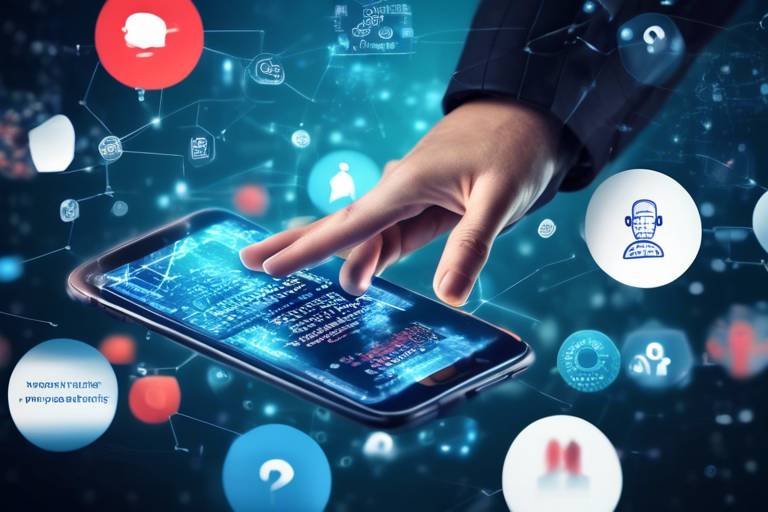The Role of Virtual Reality in Enhancing Empathy
Imagine stepping into someone else's shoes, feeling their emotions, and experiencing their life challenges firsthand. Sounds incredible, right? This is the magic of Virtual Reality (VR). It’s not just a tool for gaming or entertainment; it’s a powerful medium that can profoundly enhance our empathy. In a world that often feels divided, VR offers a unique opportunity to bridge gaps in understanding by immersing users in diverse experiences. Through these immersive journeys, individuals can gain insights into different perspectives, fostering a deeper emotional connection with others.
Empathy is more than just a buzzword; it's a vital component of human interaction. It allows us to connect on a deeper level, promoting compassion and understanding. VR technology takes this concept to a whole new level. By creating realistic simulations of various situations, it enables users to see the world through different lenses. Whether it's walking through a refugee camp or experiencing the daily struggles of a person with a disability, VR makes these experiences tangible and impactful.
As we delve into the science behind empathy, we discover that it is rooted in our neurological makeup. Empathy involves complex psychological mechanisms that enable us to resonate with others’ feelings. When we engage in VR experiences, our brain's mirror neurons activate, making us feel as if we are genuinely experiencing someone else's reality. This biological response is what makes VR such a potent tool for fostering empathy. By allowing users to not just observe but actively participate in these scenarios, VR encourages a profound emotional understanding that traditional media simply cannot achieve.
Moreover, the technology behind VR is continually evolving, making it more accessible and impactful. From headsets to haptic feedback devices, the components of VR work together to create an immersive environment that can evoke strong emotional reactions. This technology is not just about visuals; it’s about creating a holistic experience that engages all our senses. As we explore the different types of VR experiences, we see how narrative-driven, simulation-based, and gamified approaches each contribute uniquely to enhancing empathy.
In narrative-driven VR experiences, users are often placed in the shoes of characters facing significant challenges. These compelling stories allow for emotional connections that resonate deeply with participants. On the other hand, simulation-based experiences replicate real-life scenarios, offering users a chance to navigate the complexities of another person's life. Finally, gamified VR experiences incorporate elements of competition and collaboration, making empathy-building a fun and engaging process.
As we move towards the applications of VR in various fields, the potential for empathy training becomes even more evident. In healthcare, for instance, VR is being utilized to train professionals by simulating patient experiences. This training not only enhances the quality of care but also improves doctor-patient relationships, fostering a more compassionate healthcare environment. Similarly, in education, VR is transforming how students learn about diversity and social issues, promoting inclusivity and understanding from a young age.
Looking to the future, the trends in VR technology suggest even more exciting possibilities for enhancing empathy. As advancements in technology continue, we can expect to see innovations that make these experiences even more immersive and impactful. The potential for VR to influence emotional understanding in society is vast, paving the way for a more empathetic world.
- What is Virtual Reality? - Virtual Reality is a simulated experience that can be similar to or completely different from the real world, often using technology to create immersive environments.
- How does VR enhance empathy? - By immersing users in different perspectives and experiences, VR allows them to feel and understand emotions that they may not encounter in their daily lives.
- In what fields is VR being used for empathy training? - VR is being utilized in various fields, including healthcare, education, and social justice, to promote understanding and compassion.
- What are the types of VR experiences? - The main types include narrative-driven, simulation-based, and gamified experiences, each offering unique ways to engage users emotionally.

The Science Behind Empathy
Empathy is a fascinating psychological phenomenon that allows us to connect with others on a deeply emotional level. But what exactly is empathy? In simple terms, it’s the ability to understand and share the feelings of another person. Imagine walking a mile in someone else's shoes—this is the essence of empathy. It’s not just about feeling sorry for someone; it’s about truly grasping their experiences and emotions. This understanding is crucial in our daily interactions, influencing how we relate to friends, family, colleagues, and even strangers.
The importance of empathy in human interactions cannot be overstated. It fosters compassion, enhances communication, and builds stronger relationships. When we empathize with others, we create an environment of trust and cooperation. In fact, research shows that empathetic individuals are often more successful in both personal and professional relationships. But how does this all work at a neurological level?
Neuroscience has revealed that empathy is rooted in specific brain functions. When we witness someone else's pain or joy, our brains activate in ways that mirror their emotions. This phenomenon is largely attributed to the mirror neuron system, a group of neurons that fire both when we act and when we observe the same action performed by another. This mirroring effect creates a bridge between our experiences and those of others, allowing us to feel what they feel.
Here’s a quick overview of the neurological basis of empathy:
| Brain Region | Function |
|---|---|
| Anterior Cingulate Cortex | Involved in emotional regulation and decision-making |
| Insula | Processes feelings and bodily sensations |
| Mirror Neurons | Facilitates understanding of others' actions and emotions |
Moreover, empathy is not just a fixed trait; it can be cultivated and developed over time. Factors such as exposure to diverse perspectives, emotional intelligence, and even virtual reality experiences can enhance our empathetic abilities. This is where the magic of virtual reality comes into play. By immersing ourselves in different experiences, we can expand our understanding of others' emotions and challenges.
In summary, the science behind empathy is a blend of psychological and neurological factors that enable us to connect with others. Understanding these mechanisms is essential, especially as we explore innovative ways, such as virtual reality, to foster empathy in our increasingly diverse world.

This article explores how virtual reality (VR) can foster empathy by immersing users in diverse experiences, allowing them to understand different perspectives and emotions in a profound way.
Understanding the psychological mechanisms of empathy is crucial. This section delves into how empathy is defined, its importance in human interactions, and the neurological basis that supports empathetic responses.
Virtual reality technology has revolutionized the way we experience and interact with digital environments. At its core, VR creates an immersive experience that transports users into a different world, engaging multiple senses to enhance realism. The technology primarily consists of three main components: hardware, software, and content. The hardware includes headsets, motion sensors, and sometimes even haptic feedback devices, which allow users to feel sensations as they interact with the virtual environment. The software encompasses the programs that generate these immersive worlds, while content refers to the actual experiences and narratives that users engage with.
When you put on a VR headset, it’s like stepping through a portal into another reality. The visual and auditory stimuli are designed to be so convincing that users can temporarily suspend disbelief, allowing them to engage with the experience on a deeper emotional level. This immersive quality is what makes VR a powerful tool for enhancing empathy. By simulating real-life situations and perspectives, VR can evoke emotional responses that traditional media simply cannot achieve.
To better understand how VR operates, let’s break down the main types of VR technologies:
| Type of VR | Description |
|---|---|
| Fully Immersive VR | Utilizes advanced headsets and motion tracking to create a completely immersive experience. |
| Non-Immersive VR | Involves a desktop or mobile device, allowing users to interact with the virtual environment without full immersion. |
| Augmented Reality (AR) | Overlays digital information onto the real world, blending virtual elements with the physical environment. |
Each type of VR provides unique opportunities to enhance empathy. Fully immersive experiences can place users directly in the shoes of others, while non-immersive VR can still evoke emotional responses through storytelling and visual engagement. Augmented reality, on the other hand, allows users to see the world through different lenses, which can be particularly effective in educational settings.
As VR technology continues to evolve, it becomes increasingly accessible to various sectors, including education, healthcare, and social justice. The potential for VR to foster empathy is immense, as it can bridge gaps in understanding and promote compassion across diverse communities. Imagine being able to walk through the life of someone from a different background or experiencing the daily challenges faced by individuals in marginalized communities. This is the power of virtual reality.
This section highlights various fields where VR is applied for empathy training, including education, healthcare, and social justice, showcasing its potential to transform understanding and compassion in diverse contexts.
In healthcare, VR is used to train professionals in empathy by simulating patient experiences. This subsection examines how this training improves doctor-patient relationships and overall care quality.
Educational institutions are increasingly adopting VR to teach students about diversity and social issues. This subsection explores how immersive learning can cultivate empathy in young minds and promote inclusivity.
As technology advances, the future of VR in enhancing empathy looks promising. This section discusses emerging trends, potential innovations, and how they may further influence emotional understanding in society.
- What is virtual reality? Virtual reality is a technology that creates a simulated environment, allowing users to immerse themselves in a different reality through visual and auditory stimuli.
- How does VR enhance empathy? VR enhances empathy by allowing users to experience life from different perspectives, fostering emotional connections through immersive storytelling and simulations.
- What are the applications of VR in training? VR is used in various fields, including healthcare for training professionals, education for teaching diversity, and social justice to raise awareness about societal issues.

Virtual Reality (VR) is not just a flashy technology; it’s a powerful tool that can evoke a range of emotions and foster empathy in ways traditional media simply cannot. When we talk about the types of VR experiences, we’re diving into a rich tapestry of immersive environments that can transport users into the shoes of others. Each type of experience offers unique pathways to emotional engagement, making it crucial to understand how they function and what they can achieve.
At its core, VR can be categorized into three main types: narrative-driven experiences, simulation-based experiences, and gamified experiences. Each of these types serves a distinct purpose and can engage users in different ways, ultimately enhancing their capacity for empathy.
Narrative-driven VR experiences are akin to stepping into a book or movie where the user becomes an active participant in a story. Imagine donning a VR headset and suddenly finding yourself in a bustling city, experiencing the life of a refugee. These experiences often feature compelling storytelling and character development, allowing users to forge emotional connections with the characters and their struggles. This method is powerful because it allows users to not just observe but to feel and understand the emotional weight carried by others.
On the other hand, simulation-based VR experiences replicate real-life situations. Picture this: you’re in a VR scenario where you must navigate the challenges faced by someone with a disability. By immersing yourself in these scenarios, you gain insights into the daily hurdles that others face, which can significantly enhance your understanding and compassion. These experiences can be particularly useful in training environments, where professionals can prepare for real-world interactions by experiencing them firsthand in a controlled setting.
Lastly, we have gamified VR experiences, which incorporate elements of gaming to create engaging and interactive environments. Think of it as turning empathy into a game where you collaborate with others to achieve common goals. This type of experience can deepen empathy through competition and teamwork, as users must work together to overcome challenges. By blending gameplay mechanics with emotional narratives, gamified VR can turn learning about empathy into an enjoyable and impactful experience.
In summary, the different types of VR experiences—narrative-driven, simulation-based, and gamified—each offer unique ways to engage users emotionally and foster understanding. As technology continues to evolve, the potential for these experiences to enhance empathy and emotional intelligence becomes increasingly profound.
- What is the main goal of using VR for empathy training?
The primary goal is to immerse users in experiences that help them understand and relate to the emotions and challenges faced by others. - Can VR experiences really change a person's perspective?
Yes, by allowing users to experience life through another's eyes, VR can significantly shift perceptions and foster deeper understanding. - Are there any risks associated with VR empathy training?
While generally safe, it can be emotionally intense, and users may need support to process their experiences.

Narrative-driven virtual reality (VR) experiences are a powerful tool for fostering empathy by immersing users in richly crafted stories that allow them to step into the shoes of others. Imagine being able to walk through the life of someone who faces challenges vastly different from your own. This type of VR experience is not just about entertainment; it’s about **transformative storytelling** that evokes genuine emotional responses. By placing users in a narrative context, these experiences can create a deep connection to the characters and situations portrayed, leading to a greater understanding of diverse perspectives.
One of the most compelling aspects of narrative-driven VR is its ability to engage users on both an emotional and cognitive level. As users navigate through a carefully constructed storyline, they are prompted to make choices that reflect the moral dilemmas faced by the characters. This interaction can lead to a profound sense of empathy, as the user feels the weight of the decisions made within the narrative. For instance, consider a VR experience that allows you to live a day in the life of a refugee. You might encounter situations that require you to make quick decisions about safety, resources, and your family’s well-being. This kind of immersive storytelling can shatter preconceived notions and foster a deeper understanding of the struggles faced by others.
Furthermore, narrative-driven VR experiences often utilize strong character development and emotional arcs. Users can witness the growth or decline of characters as they navigate challenges, which can mirror real-life situations. This connection can be incredibly impactful. Here are some key elements that enhance the effectiveness of narrative-driven VR experiences:
- Relatable Characters: Characters that reflect real societal issues help users connect emotionally.
- Immersive Environments: Detailed settings that replicate real-world locations enhance the feeling of presence.
- Interactive Choices: Allowing users to make decisions can lead to personal investment in the story.
- Emotional Soundscapes: Music and sound effects can heighten emotional responses, making experiences more poignant.
By integrating these elements, narrative-driven VR experiences can become a catalyst for change. They encourage users to reflect on their own biases and assumptions while promoting a more inclusive worldview. As users immerse themselves in these narratives, they gain insights that are often difficult to achieve through traditional forms of media. It’s like reading a book versus living the story; the latter offers a visceral understanding that can lead to lasting change in attitudes and behaviors.
In summary, narrative-driven VR experiences are not just a novel form of entertainment; they are a groundbreaking way to cultivate empathy and understanding in an increasingly divided world. By engaging users in compelling stories, VR can break down barriers and foster connections that transcend cultural and social divides. As we continue to explore the potential of these experiences, it’s clear that narrative-driven VR has the power to change hearts and minds.
- What is narrative-driven VR? Narrative-driven VR refers to virtual reality experiences that focus on storytelling, allowing users to immerse themselves in the lives and challenges of characters.
- How does narrative-driven VR enhance empathy? By placing users in the shoes of others, narrative-driven VR fosters emotional connections and understanding of different perspectives.
- Can anyone use narrative-driven VR experiences? Yes, narrative-driven VR is designed for a wide audience, making it accessible for educational purposes, training, and personal growth.
- What are some examples of narrative-driven VR experiences? Examples include experiences that simulate the lives of refugees, individuals with disabilities, or those facing social injustices.

Simulation-based virtual reality (VR) experiences are like stepping into a different world where you can truly walk a mile in someone else's shoes. Imagine being able to experience the daily struggles of a refugee, the challenges of living with a disability, or the emotional turmoil of someone battling a severe illness. These simulations are designed to immerse users in real-life scenarios, providing a visceral understanding of the challenges faced by others. By recreating these experiences, VR allows users to not just observe but actually feel what it’s like to navigate these situations.
One of the most compelling aspects of simulation-based VR is its ability to evoke genuine emotional responses. When users find themselves in a simulated environment that mirrors the realities of another person's life, they often report feelings of empathy and compassion that are difficult to achieve through traditional media. For instance, a VR simulation might place a user in a crowded urban setting, where they must navigate the complexities of public transportation while juggling the demands of work and family. This kind of immersive experience can lead to a profound understanding of the stressors that many individuals face daily.
The technology behind these simulations is continually evolving, utilizing advanced graphics, sound design, and haptic feedback to create a realistic environment. Let’s break down some of the key components that make simulation-based VR so impactful:
| Component | Description |
|---|---|
| Visuals | High-quality graphics that create lifelike environments, enhancing immersion. |
| Audio | Spatial audio that mimics real-world sounds, making the experience more authentic. |
| Haptics | Feedback mechanisms that allow users to "feel" actions within the simulation, deepening the emotional connection. |
Moreover, simulation-based VR experiences can be tailored to different audiences and objectives. For example, in a healthcare context, medical professionals can engage in simulations that let them experience the pain and discomfort of patients. This not only enhances their understanding but also improves their bedside manner, which is crucial in healthcare settings. Similarly, in educational environments, students can participate in simulations that address social issues, fostering a sense of responsibility and empathy towards those affected by societal challenges.
Ultimately, simulation-based VR experiences serve as powerful tools for empathy building. They challenge users to confront their biases and broaden their perspectives, creating a ripple effect that can lead to more compassionate interactions in everyday life. In a world that often feels divided, these immersive experiences remind us of our shared humanity and the importance of understanding one another.
- What is simulation-based VR? Simulation-based VR involves immersive experiences that replicate real-life situations, allowing users to understand different perspectives.
- How does simulation-based VR enhance empathy? By placing users in the shoes of others, these experiences evoke emotional responses that foster understanding and compassion.
- What are some applications of simulation-based VR? It is used in healthcare for training professionals, in education to teach social issues, and in various fields to promote empathy.
- Can anyone use simulation-based VR? Yes, simulation-based VR is accessible to a wide range of users, from students to professionals seeking to enhance their empathetic skills.

Gamified virtual reality (VR) experiences are revolutionizing the way we engage with the world around us. By incorporating game mechanics into immersive environments, these experiences not only entertain but also deepen our understanding of empathy. Imagine stepping into a virtual world where you’re not just a passive observer but an active participant in a narrative that challenges your perceptions and emotions. This level of engagement can foster a profound connection to the experiences of others, making empathy not just an abstract concept but a visceral reality.
In gamified VR, users often face challenges that require them to collaborate or compete with others, creating a dynamic setting that mimics real-life social interactions. For instance, a VR game might place you in a scenario where you must work with individuals from diverse backgrounds to achieve a common goal. This experience can illuminate the struggles and triumphs of others, allowing players to walk a mile in someone else's shoes, quite literally! The emotional stakes are raised as players navigate through obstacles, fostering an environment where understanding and cooperation become essential for success.
One of the most intriguing aspects of gamified VR experiences is how they can incorporate feedback loops that reward empathetic behavior. For example, players might receive points or unlock new levels by demonstrating understanding or compassion towards virtual characters facing hardships. This not only incentivizes positive interactions but also reinforces the importance of empathy in our daily lives. By making empathy a game mechanic, developers can create an engaging platform that encourages players to reflect on their own actions and attitudes.
Additionally, gamified VR can simulate high-stakes scenarios that evoke strong emotional responses. Consider a game that places you in a conflict zone, where you must make decisions that affect the lives of others. The weight of these choices can lead to a deeper understanding of the complexities of human emotions and the consequences of our actions. This type of immersive experience can be particularly powerful in educational settings, where students can learn about social justice issues or historical events through firsthand experiences that challenge their viewpoints.
To illustrate the impact of gamified VR experiences on empathy, let's take a look at a few key elements that enhance emotional engagement:
| Element | Description |
|---|---|
| Collaboration | Working together with others encourages understanding and shared goals. |
| Competition | Healthy competition can motivate players to empathize with their opponents. |
| Feedback Mechanisms | Rewards for empathetic actions reinforce positive behavior. |
| Emotional Scenarios | High-stakes situations evoke strong emotional responses, fostering empathy. |
In conclusion, gamified VR experiences are not just about scoring points or leveling up; they are about creating connections and fostering empathy in a way that traditional methods often cannot achieve. As technology continues to evolve, the potential for these immersive experiences to transform how we understand and relate to one another is limitless. By engaging players in meaningful narratives and challenges, gamified VR has the power to cultivate a more empathetic society, one virtual experience at a time.
- What are gamified VR experiences? Gamified VR experiences incorporate game mechanics into virtual reality environments to engage users actively while fostering empathy and understanding.
- How do gamified VR experiences enhance empathy? They allow users to experience challenges and scenarios that require cooperation, competition, and emotional engagement, thus deepening their understanding of others' perspectives.
- Can gamified VR be used in education? Absolutely! Educational institutions are increasingly using gamified VR to teach students about social issues, diversity, and empathy.
- What is the future of gamified VR? The future looks promising, with advancements in technology likely to create even more immersive and impactful experiences that can further enhance empathy.

Virtual reality (VR) is not just a tool for entertainment; it has emerged as a powerful medium for empathy training across various fields. The ability of VR to immerse users into different environments and perspectives allows for a deeper understanding of others' emotions and experiences. This is particularly valuable in areas such as healthcare, education, and social justice, where fostering empathy can lead to significant improvements in how we interact with one another.
In healthcare, VR is revolutionizing the way medical professionals are trained. By simulating patient experiences, healthcare workers can step into the shoes of their patients, experiencing firsthand the challenges and emotions that accompany various medical conditions. For instance, a doctor might use VR to understand what it feels like to live with chronic pain or to navigate the complexities of mental health issues. This immersive training enhances their ability to relate to and communicate with patients, ultimately improving the quality of care. Studies have shown that doctors who undergo VR empathy training exhibit greater compassion and better patient relationships, leading to more effective treatment outcomes.
Similarly, in the realm of education, institutions are harnessing the power of VR to teach students about diversity and social issues. Imagine a classroom where students can virtually experience life in a different culture or socioeconomic background. This kind of immersive learning cultivates empathy in young minds, helping them to appreciate differences and promote inclusivity. For example, a VR program might allow students to witness the struggles of refugees, fostering a deeper understanding of their plight. Such experiences can challenge preconceived notions and encourage discussions about empathy and social responsibility.
In addition to healthcare and education, VR is making strides in the area of social justice. Activists and organizations are using VR to create awareness about social issues by placing users in the middle of real-world scenarios that highlight injustice and inequality. By experiencing these situations from a first-person perspective, individuals can gain insights that are often lost in traditional forms of media. This method has proven effective in mobilizing communities and encouraging advocacy, as people are more likely to take action when they can emotionally connect with the experiences of others.
As we explore the applications of VR in empathy training, it's essential to recognize the potential for this technology to bridge gaps between diverse groups of people. Whether it’s through healthcare professionals understanding their patients better, students learning about the world around them, or activists advocating for change, VR offers a unique avenue for cultivating empathy. The immersive nature of these experiences is akin to stepping into a new world, where the lessons learned can resonate deeply and inspire meaningful change in our interactions with others.
- How does VR enhance empathy training?
VR enhances empathy training by immersing users in experiences that allow them to see the world from different perspectives, fostering emotional connections and understanding. - What fields benefit from VR empathy training?
Fields such as healthcare, education, and social justice benefit significantly from VR empathy training, as it helps improve communication and understanding. - Is VR effective in developing empathy in children?
Yes, VR can be particularly effective in developing empathy in children by exposing them to diverse experiences and encouraging discussions about inclusivity and social issues. - What are some examples of VR applications in healthcare?
Examples include simulations that allow healthcare professionals to experience patient conditions, enhancing their understanding and compassion towards patients.

In the ever-evolving landscape of healthcare, Virtual Reality (VR) stands out as a groundbreaking tool that is transforming how medical professionals are trained. Imagine stepping into the shoes of a patient, feeling their pain, understanding their fears, and experiencing their journey firsthand. That's the essence of VR in healthcare—it allows healthcare providers to immerse themselves in the experiences of their patients, fostering a deeper sense of empathy.
One of the most significant applications of VR in healthcare is in the training of medical professionals. Traditional methods of training often rely on textbooks and simulations that lack the emotional depth needed for effective learning. With VR, trainees can engage in realistic scenarios that replicate the challenges patients face, which is crucial for developing not only clinical skills but also the emotional intelligence necessary for effective patient care.
For instance, consider a scenario where a medical student uses VR to experience the world from the perspective of a patient with chronic pain. This immersive experience can evoke a profound understanding of the patient's struggles, leading to more compassionate care. By understanding the emotional and psychological aspects of their patients' conditions, healthcare providers can improve their communication, build trust, and ultimately enhance the quality of care.
Furthermore, VR is being utilized in therapeutic settings as well. It has shown promise in treating conditions like PTSD, anxiety, and phobias by allowing patients to confront their fears in a controlled environment. This not only aids in their recovery but also helps therapists understand their patients' experiences more intimately. The ability to visualize and empathize with a patient's emotional state is invaluable in creating effective treatment plans.
To illustrate the impact of VR in healthcare, let's look at a few key benefits:
- Enhanced Empathy: By experiencing patient scenarios, healthcare providers can develop a deeper emotional connection with their patients.
- Improved Communication: Understanding a patient's perspective leads to better communication and rapport.
- Effective Training: VR provides realistic training environments that prepare medical professionals for real-life challenges.
- Therapeutic Benefits: VR is an effective tool in treating various mental health conditions, providing a safe space for exposure therapy.
As we look to the future, the integration of VR into healthcare training and therapy is likely to expand. With advancements in technology, we can expect even more immersive experiences that will not only enhance the skills of healthcare professionals but also improve patient outcomes. The potential for VR to bridge the emotional gap between providers and patients is immense, making it an essential component of modern healthcare.
Q: How does VR improve empathy in healthcare?
A: VR allows healthcare professionals to experience patient perspectives, fostering a deeper understanding of their emotional and physical challenges.
Q: What conditions can VR help treat?
A: VR has been used effectively in treating PTSD, anxiety, phobias, and chronic pain by providing immersive therapeutic experiences.
Q: Is VR training effective for medical professionals?
A: Yes, VR training has been shown to enhance clinical skills and emotional intelligence, leading to better patient care.
Q: Are there any risks associated with VR in healthcare?
A: While VR is generally safe, some individuals may experience motion sickness or discomfort. It's important to tailor experiences to individual needs.

Imagine stepping into a classroom where the walls dissolve, and you're suddenly standing in the heart of ancient Rome, witnessing the grandeur of the Colosseum firsthand. Virtual Reality (VR) in education is not just a futuristic concept; it's a transformative tool that reshapes how we learn and understand the world around us. By immersing students in rich, interactive environments, VR fosters a deeper connection to the material, making lessons memorable and engaging.
One of the most exciting aspects of VR in education is its ability to promote empathy through experiential learning. Students can experience life from different perspectives, whether it's walking in the shoes of a refugee, understanding the challenges faced by individuals with disabilities, or exploring the cultural nuances of different societies. This kind of immersive learning can cultivate a sense of compassion and understanding that traditional teaching methods often struggle to achieve.
Furthermore, VR can break down geographical barriers, allowing students from different parts of the world to connect and collaborate in a shared virtual space. For instance, a classroom in New York can join a VR session with students in Tokyo, engaging in discussions about global issues and cultural exchange. This not only enhances their learning experience but also promotes a sense of global citizenship and awareness.
To illustrate the impact of VR in education, let's look at some key applications:
| Application | Description | Benefits |
|---|---|---|
| Field Trips | Virtual excursions to historical sites, museums, and ecosystems. | Enhanced engagement and understanding of diverse subjects. |
| Historical Reenactments | Experiencing significant historical events in a virtual setting. | Deeper emotional connection and retention of historical facts. |
| Science Simulations | Conducting experiments in a safe, virtual lab environment. | Hands-on learning without the risks associated with real experiments. |
As we delve deeper into the potential of VR, it's essential to recognize that the technology is still evolving. Educational institutions are increasingly adopting VR tools to enhance their curricula, but challenges such as cost, accessibility, and the need for trained educators remain. However, with continuous advancements and decreasing costs, VR is becoming more attainable for schools worldwide.
In conclusion, the integration of VR into education is a game-changer. It not only makes learning more interactive and fun but also instills a sense of empathy and understanding among students. As we continue to explore the capabilities of VR, we can only imagine the profound impact it will have on future generations, shaping not just knowledgeable individuals, but compassionate and empathetic global citizens.
- What is Virtual Reality in education?
Virtual Reality in education involves using immersive technology to create interactive learning environments that enhance student engagement and understanding.
- How does VR foster empathy?
VR allows students to experience different perspectives and challenges, promoting emotional connections and understanding of diverse life situations.
- Are there any challenges to implementing VR in schools?
Yes, challenges include cost, accessibility, and the need for trained educators to effectively integrate VR into the curriculum.
- What are some examples of VR applications in education?
Examples include virtual field trips, historical reenactments, and science simulations that allow hands-on learning in a safe environment.

The landscape of virtual reality (VR) is evolving rapidly, and its potential to enhance empathy is becoming increasingly recognized across various sectors. As technology continues to advance, we can anticipate a wave of innovations that will further deepen our emotional understanding of one another. Imagine stepping into a world where you can experience life from another person's perspective, not just through a screen but in a fully immersive environment that feels incredibly real. This is the future that VR promises, and it’s exciting!
One of the most promising trends is the integration of artificial intelligence (AI) with VR experiences. By leveraging AI, developers can create more personalized and adaptive VR simulations that respond to user emotions in real-time. For instance, AI can analyze a user's reactions and modify scenarios to enhance emotional engagement. This means that users could experience tailored narratives that resonate more deeply, thereby fostering a stronger sense of empathy.
Moreover, the incorporation of social VR platforms is set to revolutionize how we connect with others. These platforms allow users to interact in shared virtual spaces, breaking geographical barriers and enabling cross-cultural exchanges. Imagine having a conversation with someone from a completely different background while experiencing their life circumstances through VR. This social aspect can amplify understanding and compassion among diverse groups, making empathy a shared experience rather than an isolated one.
Another exciting trend is the application of VR in mental health therapy. Therapists are beginning to use VR as a tool to help patients confront their fears and understand the emotional experiences of others. For example, a patient dealing with anxiety might use VR to step into the shoes of someone who has successfully navigated similar challenges. This not only helps them see the world differently but also cultivates a sense of shared humanity and connection.
Furthermore, educational institutions are increasingly recognizing the value of VR in teaching empathy. Future classrooms may utilize VR to simulate historical events or social issues, allowing students to experience these moments firsthand. This immersive learning approach can spark discussions, encourage critical thinking, and foster a generation that values empathy and inclusivity. Imagine students walking through a VR simulation of a civil rights march, feeling the weight of history and the power of collective action!
Finally, as VR technology becomes more accessible, we can expect to see a rise in community-driven VR projects. These initiatives often focus on storytelling from underrepresented voices, allowing users to engage with narratives that they may not encounter in their everyday lives. By amplifying these stories, VR can serve as a powerful tool for social change, promoting empathy and understanding in ways that traditional media cannot.
In summary, the future of VR in enhancing empathy is bright and full of potential. With advancements in AI, the rise of social VR platforms, applications in mental health, educational innovations, and community-driven projects, we are on the brink of a new era where empathy can be cultivated more effectively than ever before. The question remains: how will we harness this technology to create a more compassionate world?
- What is the role of AI in VR empathy experiences? AI can personalize VR experiences by adapting scenarios based on user emotions, enhancing emotional engagement.
- How can VR be used in education to teach empathy? VR can simulate historical events or social issues, allowing students to experience these moments firsthand, fostering understanding and inclusivity.
- Are there any mental health applications for VR? Yes, VR is being used in therapy to help patients confront fears and understand others' emotional experiences.
- What are social VR platforms? These platforms allow users to interact in shared virtual spaces, facilitating cross-cultural exchanges and enhancing empathy.
Frequently Asked Questions
- What is virtual reality and how does it relate to empathy?
Virtual reality (VR) is an immersive technology that creates a simulated environment, allowing users to experience different perspectives and emotions. By placing users in the shoes of others, VR fosters a deeper understanding of diverse experiences, which is essential for building empathy. Imagine stepping into someone else's life and feeling what they feel—that's the magic of VR!
- How does VR enhance empathy compared to traditional methods?
Unlike traditional methods that may rely on storytelling or lectures, VR engages users in a more interactive and immersive way. It allows individuals to not just hear about someone else's struggles but to actually experience them firsthand. This level of engagement can create a lasting emotional impact that simply reading or watching a video often can't achieve.
- Can VR experiences be tailored to specific audiences?
Absolutely! VR experiences can be designed to cater to various audiences, whether it's for healthcare professionals, students, or social justice advocates. By customizing scenarios to reflect the challenges faced by specific groups, VR can effectively enhance empathy and understanding in a targeted manner.
- What types of VR experiences are most effective for empathy training?
There are several types of VR experiences that can effectively enhance empathy, including narrative-driven experiences that tell compelling stories, simulation-based experiences that replicate real-life challenges, and gamified experiences that encourage collaboration and competition. Each type offers unique ways to engage users and foster emotional connections.
- How is VR being used in healthcare to improve empathy?
In healthcare, VR is used to simulate patient experiences, helping professionals understand the emotional and physical challenges their patients face. This training can improve doctor-patient relationships and lead to more compassionate care. Imagine a doctor experiencing the anxiety of a patient before surgery—this perspective can significantly enhance their empathy!
- What role does VR play in education for fostering empathy?
Educational institutions are increasingly using VR to teach students about diversity, social issues, and empathy. By immersing students in scenarios that highlight different life experiences, VR promotes inclusivity and understanding among young minds, preparing them to be more compassionate individuals in society.
- What are the future trends for VR in enhancing empathy?
The future of VR in enhancing empathy looks bright! As technology advances, we can expect more sophisticated simulations, improved accessibility, and innovative applications across various fields. These trends have the potential to further influence emotional understanding and compassion in society, making empathy training more effective and widespread.



















